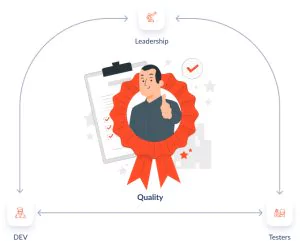When you’re developing your software product, you surely engage in the war against bugs. Even though the quality assurance process has definite standards, and you know how to achieve them, there is always room for improvement.
The above mentioned statement does sound too obvious, but what if we say that advanced software testing can become your competitive advantage? The reason is simple: a high-quality software always wins over a bug-flooded one. JatApp’s QA engineer says: “Quality is a factor that really differentiates a barely working and inconvenient software from a solution you use with pleasure and effectiveness”.
In fact, software of poor quality causes 40% of annual losses. Consequently, a digital product of extra quality is likely to give an additional competitive advantage for your business. Since the issue of quality works in both directions, it’s no wonder you ask: “How do I improve my bug-hunting skills to make software quality my strength?” The JatApp team knows the answer, so in this article, we’ll share some of our software testing best practices.
Ways to improve your fighting strategy against bugs
Undoubtedly, you can advance your software quality assurance combat skills in a myriad of ways, so we share only those QA best practices JatApp has been using for years. We’re confident in their effectiveness, since we have used them in more than 200 digital projects, and 99% of our customers were satisfied with the quality of software we delivered to them.
Make software quality assurance a part of mission and build a strong quality leadership
Quality assurance has to become a part of your company’s mission statement. The top-level governance of your company is kind of obliged to share the message that quality assurance and software testing is a paramount aspect of the business.
Above-average software testing practices and quality assurance culture are not just a coincidence as you can intentionally foster them inside your company. Quality assurance reaches its excellence when it becomes a priority on all levels of business.
Needless to say, the QA team lead plays a significant role in promoting culture of quality as well. Our QA engineer mentions: “Having a leader is the first and foremost way of improving our QA practices. When our team got a professional QA lead, all processes started working more effectively, communication improved, and each team member got their own key performance indicators to follow”.
A strong leadership within the software quality assurance team is also critical to the team’s adaptability to changes. Our QA engineer admits: “Just imagine how hard it is to keep the quality at the highest level when one day you debug a monitoring platform for electric vehicle charging stations, and the next day you have to review the code for a property management solution. Changing requirements is okay today, but a good leader is a must in this case”.
In such a way, QA lead has to be the one who coordinates the team to stay maximally flexible when it comes to a constant change of project requirements.
Overall, top managers and executives are expected to make quality assurance the heart and soul of the company’s culture, while your QA team lead is the one who makes this culture work within the testing team and across the whole organization.
Ensure proper planning
An advanced quality assurance necessarily involves a well-planned testing strategy that is recorded in several documents that define QA processes on various levels: test policy, quality management plan, test strategy, test plan, and test case.
When all processes are documented and stated clearly, the QA team as well as other teams within the project have a better understanding of how software testing should work. As a result, your QA team is able to kill more bugs and deliver much cleaner software. For that reason, getting the details about commonly used testing documentation is worth your attention.
Test documentation can be really boring, but you still need it
Test policy
Test policy is a document that describes the general principles of software testing in the company and sets the main test objectives as well as the ways to measure them. There is no specific format for test policy, but it usually includes information about:
- Definition of software testing process and its role in the company
- Test objectives
- General standards and quality criteria for the company’s software
- Definition of terms related to testing and quality assurance
- Tools necessary for testing and QA
- Measures for evaluating testing effectiveness
- How process improvement in software testing can be managed.
Quality management plan
A quality management plan is a document that describes an acceptable level of software quality. Quality management plan usually describes how the project team has to achieve these quality standards. The main components of quality management plan typically includes:
- Quality objectives
- Main project deliverables and processes required for achieving the highest quality level
- Quality standards
- Quality assurance procedures
- QA team’s roles and responsibilities
- Software quality assurance reporting plan
Test strategy
This document is more product-specific as test strategy stems from business requirements of the software to be developed. Thus, test strategy document should answer the following questions:
- What is the product?
- What components of the product require testing?
- What tests are necessary?
- When should testing start?
- What are the acceptance criteria?
Test plan
As for the testing plan, it simply states what, where, when, and by whom a solution should be tested during the software development life cycle (SDLC). Your test plan needs to cover such aspects as:
- Product analysis
- Test strategy design
- Test objectives design
- Test criteria definition
- Resource planning
- Test environment planning
- Schedule & estimation
- Test deliverables determination.
Test case
A typical test case contains information about the type of test, actions required, target result, and test status. The formats of test cases vary, so it’s up to your QA team which one works for them best. Still, we encourage you to check an image below to get a better idea.
Involve your QA team as early as possible
The best QA strategy is to prevent defects and errors before the code is actually written. That is why participation of the QA team should start from the first days of the project. The reason is plain: the QA team has to be familiar with the solution under development to provide maximally effective quality assurance. An early involvement of the QA team brings more chances to implement test strategies that seriously decrease the number of bugs.
Even though you add more procedures at the early stages of your project, it will progress much faster, once the majority of bugs are dead before the testing phase comes. This approach is called “Shifting left” (no political affiliations are meant) and it aims at bug elimination at the early stage of your project instead of conventional way of running tests late within the development life cycle.
Comparison of traditional Agile approach and shifting left strategy
“How is it possible to test the product after every single stage and win much time and money ahead?” — you may wonder. Actually, test automation is the main time-saver in this case. Aside from time reduction, test automation helps to avoid a human factor in the QA process and advances test capacity. That’s why we would like to emphasize that you need to automate as many tests as you can.
In addition, automation gives your QA engineers an opportunity to focus on testing features that were rolled out recently, while they can be confident that the early functionality is bugless. You don’t necessarily need to create sophisticated testing scripts to have all these advantages, as even small automation scripts can save testing time.
Shifting left makes good use of automated testing. The mainstream Agile approach means that a product undergoes design and development for a two-weeks sprint. Then, all tests take place within two weeks as well.
Instead, shifting left involves manual testing simultaneously with the design and development processes. The quality of a release is still under control and you have enough scripts to automate tests for the next release, thereby allowing your QA team to work with a new portion of functionality.
So, we see that attacking bugs from the left is a strategy that can help you to keep the enemy within their borders. Therefore, you need some tricky tactics to make this QA strategy work:
- Prioritize feedback. Since the testing team works with defect detection on early stages of the project, developers and designers need to choose what bugs should “die” first. Setting these priorities according to the software’s requirements and severity of a potential defect is just common sense.
- Manage acceptance of processes. Once your coding and design teams have set the priorities, there should be specific requirements that determine whether a detected bug became a good guy and now works in the name of your product’s quality.
- Ensure resources availability. Since testing and feedback are the central value for shifting left strategy, it means you have to provide all necessary resources to these activities. Saving on resources for testing and feedback makes the entire shifting left process unreasonable as you won’t get the results you intended to have with this QA practice.
- Pursue maximal automation. Well, we’ve already mentioned the importance of automation, but since it’s so vital, we would like to make an emphasis once again. Automation is a key principle of shifting left strategy, which is why adding as many automated tests as possible helps you to advance your software quality assurance with every next release of your product.
- Establish necessary infrastructure. Even though your QA team starts testing as early as possible, you may not have valid testing environments, so all the efforts can be in vain. So, make sure you have all necessary infrastructure in place before your QA team starts bug hunting.
Pursue testing tools mastery
Except for automation, the other testing tools necessary for quality assurance are extremely important. They provide QA teams with opportunities to detect and fix bugs with better precision, be more systemic with the testing process, and gain experience that can be used in future projects.
Our QA engineer notes: “Various tools enable us to understand the nature of a particular defect or create perfect environments for testing. The more tools we can operate with, the more accurate testing we can deliver”. In such a way, arming your QA team with as many testing instruments as possible is always a reasonable thing to do. “If you have to learn about something that looks odd and unnecessary, don’t resist. You may need this tool soon.” — Our QA engineer concludes.
Make your development life cycle test-oriented
Test-driven development (TDD) is a software development process that involves tests before code deployment. Development of every single feature starts with a test creation. The QA team writes a script for an automated test case before the development team writes enough code to run this test.
If the test fails (in most cases, it will for the first time), the QA team rewrites the test with consideration of defects they detected. Then, the development team refactors the code and the updated test is executed once again.
This approach to software development and testing makes sure that all features of your product are sufficiently free from bugs, so you won’t read angry comments left by users. Even though TDD may take time, you can be confident that you don’t waste money on production of badly-written code.
Moreover, with TDD approach, code tends to get simplified, so you’re less likely to spend many resources on support and update roll-outs. Additionally, your QA team does a huge job running so many tests, so they can document everything to avoid the same mistakes in the future.
Also, you can arrange so-called pair programming during the process of product development. It means that you break your development team into pairs, in which one person writes a code, and the other person watches them and proposes their corrections. Such a peer-reviewed approach to code writing significantly reduces the number of bugs, while your development team is getting familiar with the quality standards in practice.
Arrange formal technical reviews
A formal technical review (FTR) is a meeting arranged by the QA team to detect any functional and logical errors as early as possible. At FTR, the project teams discuss how they’ll meet the quality requirements.
A standard FTR requires the whole team to discuss and review what could have been done. By the end of each meeting, the FTR document is expected to answer such questions as:
- What was reviewed?
- Who reviewed it?
- What findings and decisions were made?
The FTR can be of different types, so each type has its own functions: A formal review or review meeting, a walkthrough, and inspection.
A formal review is a meeting when the product is introduced to the reviewers for the first time. All team members need to accept the product, make comments, and correct the delivery schedule.
A walkthrough is a meeting during which the team analyzes the source code of the product, user interface and user experience design, and software requirements. This meeting usually intends to detect bugs before releasing the first build.
An inspection is a review session when extra requirements to the quality and functionality are added. While formal reviews and walkthroughs are devoted to bug detection, inspections are necessary for advancing standards or making sure that the previous bugs are really dead.
Arrangement of FTR helps to reduce the risk of logic errors and deployment errors beforehand. Also, it helps the development team to have a bird-eye view of the entire product, thereby making development planning more realistic.
Exploratory testing
Exploratory testing is a type of software testing that doesn’t use any cases, and a test is performed on the go. The QA team uses their past experience and intuition (which is based on past experience anyway) to predict what part of the solution should be tested and how.
Then, the testing team detects some bugs and errors that become the starting point for writing automated tests, cases, or even individual updates to the documents we described above.
Exploratory testing significantly speeds up testing documentation records, makes unit testing more convenient, and helps to create a feedback loop that can result in adoption of new software quality assurance practices.
Also, exploratory testing means that you start it as a manual test, so you can find defects a smart program would never think of. “Before you take your broken car to the service, first of all you have to look under the hood on your own” — ironically commented JatApp’s QA engineer.
Still, before your QA team goes for an extravagant testing improvisation, they need to get prepared by following the next steps:
- Creation of bug classification
- Create groups of errors based on the past experience
- Perform a root cause analysis for each group of bugs
- Define the risks and brainstorm ideas for testing.
- Test charter development
- What should be tested?
- How can you test this part of the software?
- What extra measures do you need to take?
- Running time box testing
- Get a pair of QA specialists to work together for not less than 90 minutes with no interruption.
- Extend or reduce testing by 45 minutes, if necessary.
- Review the findings
- Evaluate all the bugs
- Define what you’ve learnt
- Analyze areas which could be covered better.
- Make conclusions and use them for specified tests
- Compile the results
- Compare the results with the test charter
- Decide whether you need any additional testing
Facing your fears helps to defeat bugs
Destroying bugs means to engage in a continuous software testing improvement. Furthermore, if you want to make the quality of your software a competitive advantage, you shouldn’t be afraid to use the new software quality assurance approaches we described in this article.
To be more confident with implementing best practices in software testing, you can ask JatApp for help. Our company has been providing quality assurance and testing services since 2015, so we’re a reliable agency which will get you covered at the quality assurance battlefield.
If you want us to help you to take your software testing to the next level, contact us. We’ll get back to you as soon as possible.
















